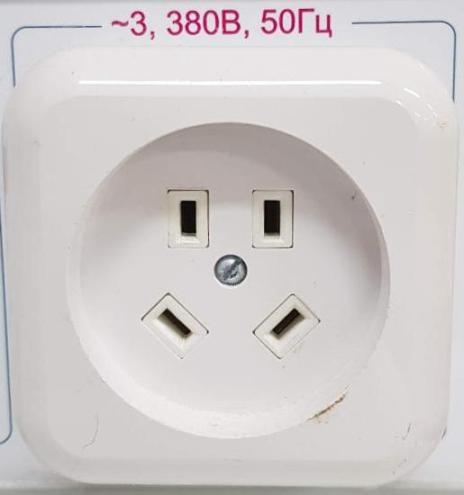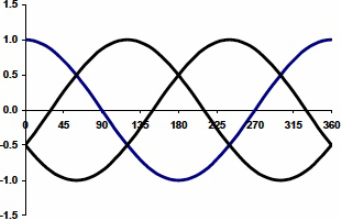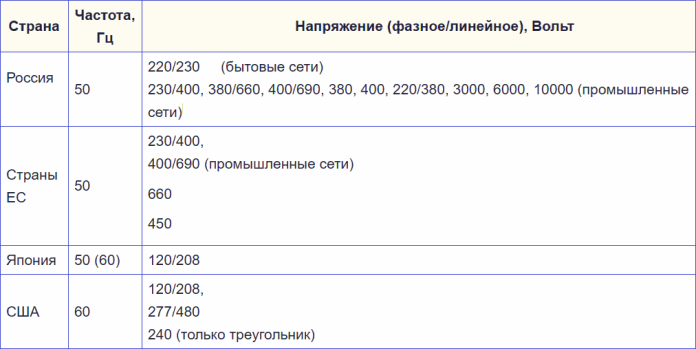Categories: Featured Articles » Novice electricians
Number of views: 2189
Comments on the article: 0
Three phase power supply system
One of the options for a multiphase power supply system is a three-phase AC system. It has three harmonic EMFs of the same frequency, created by one common voltage source. The EMF data is shifted relative to each other in time (in phase) by the same phase angle equal to 120 degrees or 2 * pi / 3 radians.
The first inventor of a six-wire three-phase system was Nikola TeslaHowever, a significant contribution to its development was made by the Russian physicist-inventor Mikhail Osipovich Dolivo-Dobrovolsky, who proposed using only three or four wires, which gave significant advantages, and was clearly demonstrated in experiments with asynchronous electric motors.

In a three-phase AC system, each sinusoidal EMF is in its own phase, participating in a continuous periodic process of electrification of the network, therefore the EMF data is sometimes referred to simply as “phases”, as are the transmitting EMF data conductors: first phase, second phase, third phase. The phases are shifted relative to each other by 120 degrees, and the corresponding conductors are usually denoted by the Latin letters L1, L2, L3 or A, B, C.

Such a system is very economical when it comes to the transmission of electrical energy by wire over long distances. Three-phase transformers are less material intensive.
Power cables require less conductive metal (copper is usually used), since currents in phase conductors, compared to single-phase ones, have lower effective values when compared with single-phase circuits of similar transmitted power.
The three-phase system is very balanced, and exerts a uniform mechanical load on the power generating installation (generator of the power plant), thereby extending its service life.

With the help of three-phase currents passed through the windings of electrical consumers - various installations and motors, it is easy to obtain a rotating eddy magnetic field necessary for the operation of motors and other electrical appliances.
Synchronous and asynchronous three-phase AC motors have a simple device, and are much more economical than single-phase and two-phase, and even more so - classical DC motors.
With a three-phase network in one installation, you can get two operating voltages at once - linear and phase, which allows you to have two power levels depending on the winding connection scheme - “triangle” (English version “delta”) or “star”.
As for the power supply of lighting systems, by connecting three groups of lamps - each to different phases of the network - you can significantly reduce flicker and get rid of the harmful stroboscopic effect.
These advantages just determine the widespread use of a three-phase power supply system in today's large global electric power industry.
Star

The connection according to the "star" scheme involves the connection of the ends of the phase windings of the generator to one common "neutral" point (neutral - N), as well as the ends of the phase outputs of the consumer.
The wires connecting the phases of the consumer with the corresponding phases of the generator are called linear wires in a three-phase network. And the wire connecting the neutrals of the generator and the consumer with each other is a neutral wire (marked “N”).
In the presence of neutral, a three-phase network turns out to be four-wire, and if there is no neutral - three-wire. Under conditions when the resistances in the three phases of the consumer are equal to each other, that is, provided that Za = Zb = Zc, the load will be symmetrical. This is an ideal mode of operation for a three-phase network.
If there is a neutral, phase voltage is called voltage between any phase wire and a neutral wire. And the voltages between any two phase wires are called linear voltages.
If the network has a star connection, then under symmetrical load the relationship between phase and linear currents and voltages can be described by the following relationships:

It can be seen that the linear voltages are shifted relative to the corresponding phase voltages by an angle of 30 degrees (pi / 6 radian):

The power at the connection of the "star" in a symmetrical load, taking into account known phase voltages, can be determined by the formula:

On the importance of neutral and phase imbalance
Although with an absolutely symmetrical load, power supply to consumers is possible through three wires with linear voltages even in the absence of neutral, nevertheless, if the loads on the phases are not strictly symmetrical, neutral is always required.
If, with an asymmetric load, the neutral wire breaks, or its resistance increases for some reason, a “phase imbalance” occurs, and then the loads on the three phases can be under different voltages - from zero to linear - depending on the distribution of the load resistances phases at the time of neutral break.
But the loads are nominally designed strictly for phase voltages, which means that something can fail. The phase imbalance is especially dangerous for household appliances and electronics, because because of this, not only some device can burn out, but also a fire can happen.
Problem of harmonics multiple of the third
Most often, household and other appliances are equipped today with switching power supplies, and without an integrated power factor correction circuit. This means that the moments of consumption are limited by thin pulsed current peaks near the top of the mains sinusoid, when the output filter capacitor installed after the rectifier is quickly and quickly recharged.
When there are many such consumers connected to the network, a high current of the third harmonic of the main frequency of the supply voltage occurs. These harmonic currents (multiples of the third) are summed in the neutral conductor and are able to overload it, despite the fact that the power consumption at each phase does not exceed the permissible one.
The problem is especially relevant in office buildings, where many different office equipment are located in a small space. If all built-in switching power supplies had power factor correction circuits, this would solve the problem.
Triangle

The connection according to the "triangle" scheme assumes from the generator side the connection of the end of the first phase conductor with the beginning of the second phase conductor, the end of the second phase conductor with the beginning of the third phase conductor, the end of the third phase conductor with the beginning of the first phase conductor - it turns out a closed figure - a triangle.
Linear and phase voltages and currents with a symmetrical load, with respect to the connection "triangle", are correlated as follows:

Power in a three-phase circuit when connected by a triangle, under conditions of symmetrical load, is determined as follows:

The table below shows the phase and line voltage standards for different countries:

Conductors of different phases of a three-phase network, as well as neutral and protective conductors, are traditionally marked with their own colors.
This is done in order to prevent electric shock and ensure the convenience of network maintenance, to facilitate their installation and repair, as well as to standardize the phasing of equipment: the phase sequence is sometimes very important, for example, to set the direction of rotation of an induction motor, the operation mode of a controlled three-phase rectifier etc. In different countries the color marking is different, in some it is the same.
See: Wire color coding
See also at bgv.electricianexp.com
:
